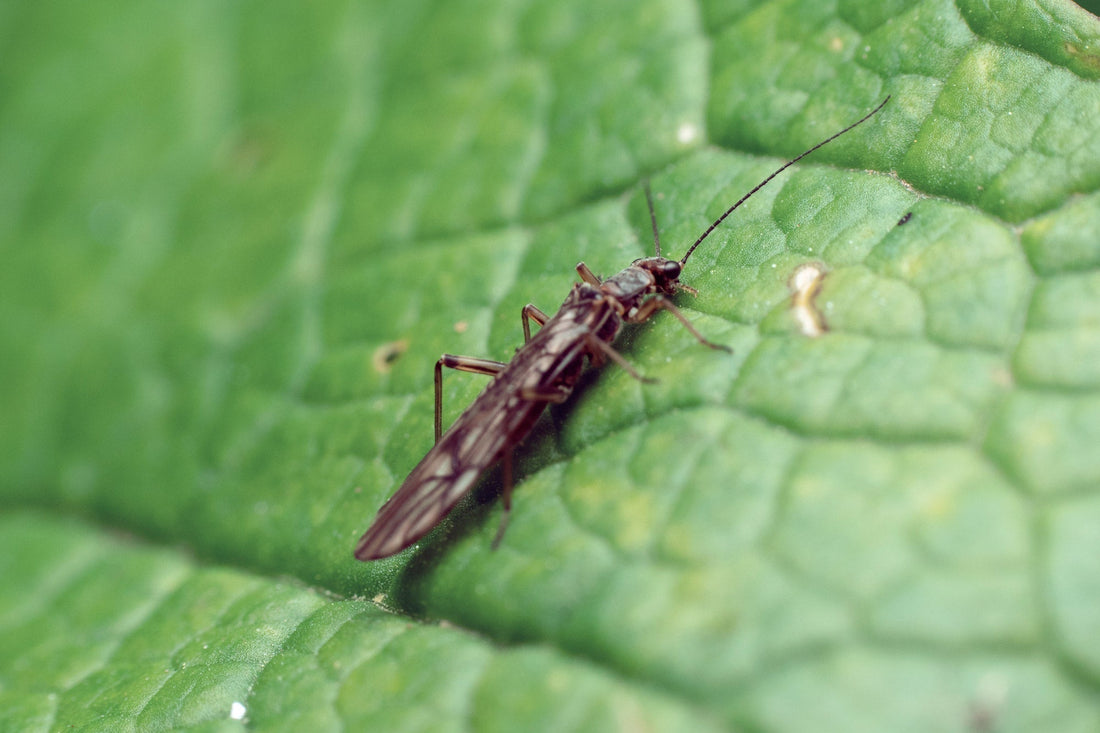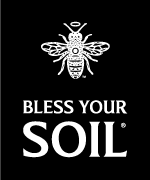
Silvery streaks, tiny black dots, and warped new leaves usually mean one thing: thrips. These tiny pests are stubborn because they lay eggs inside leaf tissue, so a single spray won’t solve it. Below is a complete, easy plan to clear them with Big Leaf Energy® and help your plant bounce back fast.
Why thrips are so stubborn
Thrips are masters of survival. They pierce leaves to feed on sap and insert their eggs inside the leaf tissue. That means sprays or drenches can’t reach the eggs—only the live adults and larvae on the surface. Within 5–7 days, those hidden eggs hatch, and a new generation appears.
👉 The key to winning is consistency. By repeating treatments every week for 3–4 weeks, you’ll break the life cycle and finally stop the infestation.

Identifying thrips: This is what thrip damage looks like on a houseplant leaf.
Using Big Leaf Energy® as a foliar spray
The foliar spray is your first line of defense against thrips. Sprays make direct contact with the pests, especially on new leaves and undersides where they feed, and Big Leaf Energy® goes further than plain neem oil or insecticidal soap alone by combining the protective power of neem with essential oils and natural surfactants — giving you a more complete, effective knockdown and shine in a single treatment.
Directions
- Shake the bottle well.
- Spray until leaves glisten—cover tops, undersides, stems, and growth tips.
- Use RTU straight from the bottle, or dilute up to half strength if your plant is delicate (like calatheas or ferns).
- Wipe any buildup with a soft cloth or Leaf Lovers™ dusting gloves.
- Repeat every 5–7 days for 3–4 weeks.

Pro tip: Spray in the morning or evening, not in direct hot sun, to avoid leaf burn and allow even drying.
Using Big Leaf Energy® as a soil drench
A soil drench can help if thrips are also hiding near the soil surface or if you want total plant coverage. Think of it as a supplemental tool rather than your main strategy.
Unlike plain neem oil (greasy, uneven coverage) or insecticidal soap alone (short-lived), Big Leaf Energy® combines neem, essential oils, and natural surfactants in a balanced formula. The result is smoother coverage without the mess, faster knockdown of pests, and a lasting, healthy shine that keeps your plants looking their best.
Directions
- Mix 5–10 mL per gallon of water (≈ 1–2 tsp/gal).
- Slowly pour the solution through the soil until water drains from the pot.
- Allow the plant to drain fully; keep it in bright shade with good airflow until dry.
- Limit drenches to once every 2–3 weeks to avoid stressing roots.

Note: A drench will not affect eggs inside leaves, but it may help flush thrips lurking near the soil line.
Spraying vs. drenching: which is better?
- Spraying is the most effective and safest long-term method. It directly targets adults and larvae where they feed (leaf undersides and new growth).
- Drenching is optional. It’s most useful as a one-time “reset” for small plants or heavy infestations but should not replace your spray routine.
Your 4-Week Thrip Treatment Schedule
| Day | What to do | Why it matters |
|---|---|---|
| 1 | Spray thoroughly (RTU or half strength). Optional drench at 5–10 mL/gal for heavy infestations. | Knocks back live adults and larvae. |
| 5–7 | Repeat spray. | Kills hatchlings from eggs inside leaves. |
| 12–14 | Repeat spray. | Interrupts breeding cycle. |
| 19–21 | Final spray in the cycle. | Confirms control; move to maintenance (every 2–3 weeks). |
Recovery & prevention
- Isolate infested plants until clear.
- Boost humidity slightly—thrips thrive in hot, dry air.
- After week two, feed with Big Green Leaves® to push fresh, healthy growth.
- Keep using Big Leaf Energy® every 2–3 weeks as a preventative polish and shield.
Thrip Treatment FAQ
Does Big Leaf Energy® kill thrip eggs?
No. Thrip eggs are inside the leaf, where sprays and drenches can’t reach. That’s why repeating every 5–7 days for 3–4 weeks is essential—each cycle catches new hatchlings before they mature.
Will a soil drench harm roots?
Not at 5–10 mL per gallon when spaced out every 2–3 weeks. Overuse could stress roots, which is why foliar sprays remain the main treatment method.
Which is better—spraying or drenching?
Spraying is most effective and safest for ongoing control. Drenching is optional and best for small plants or heavy outbreaks. Use it as a supplement, not a replacement.

- Big Leaf Energy® (RTU & Concentrate)
- Big Green Leaves® (gentle, complete plant food)


